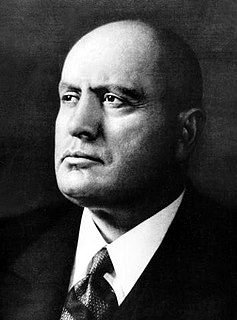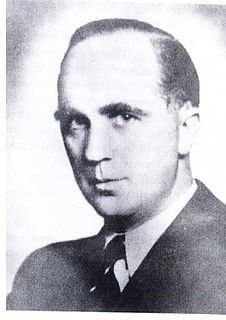
Fascism is a form of far-right, authoritarian ultranationalism characterized by dictatorial power, forcible suppression of opposition, and strong regimentation of society and of the economy, which came to prominence in early 20th-century Europe. The first fascist movements emerged in Italy during World War I, before spreading to other European countries. Opposed to liberalism, democracy, Marxism, and anarchism, fascism is placed on the far right within the traditional left–right spectrum.

Joachim von Ribbentrop was a German politician who served as Minister of Foreign Affairs of Nazi Germany from 1938 to 1945.

The Axis powers, originally called the Rome–Berlin Axis, was a military coalition that fought in World War II against the Allies. The Axis powers agreed on their opposition to the Allies, but did not completely coordinate their activity.

The Pact of Steel, known formally as the Pact of Friendship and Alliance between Germany and Italy, was a military and political alliance between Italy and Germany.

The European theatre of World War II was the main theatre of combat during World War II. It saw heavy fighting across Europe for almost six years, starting with Germany's invasion of Poland on 1 September 1939 and ending with the Western Allies conquering most of Western Europe, the Soviet Union conquering most of Eastern Europe and Germany's unconditional surrender on 8 May 1945. The Allied powers fought the Axis powers on two major fronts as well as in a strategic bombing offensive and in the adjoining Mediterranean and Middle East theatre.

The causes of World War II, a global war from 1939 to 1945 that was the deadliest conflict in human history, have been given considerable attention by historians from many countries who studied and understood them. The immediate precipitating event was the invasion of Poland by Nazi Germany on September 1, 1939 and the subsequent declarations of war on Germany made by Britain and France, but many other prior events have been suggested as ultimate causes. Primary themes in historical analysis of the war's origins include the political takeover of Germany in 1933 by Adolf Hitler and the Nazi Party; Japanese militarism against China, which led to the Second Sino-Japanese War; Italian aggression against Ethiopia, which led to the Second Italo-Ethiopian War and Germany's initial success in negotiating the Molotov–Ribbentrop Pact with the Soviet Union to divide the territorial control of Eastern Europe between them.

In the context of the history of the 20th century, the interwar period was the period between the end of the First World War on 11 November 1918 and the beginning of the Second World War on 1 September 1939.
The Four-Power Pact, also known as the Quadripartite Agreement, was an international treaty that was initialled on June 7, 1933 and signed on July 15, 1933, in the Palazzo Venezia, Rome. The Pact was not ratified by the French Parliament.

The "Manifesto of Race", sometimes known as the Charter of Race or Racial Manifesto, was a manifesto published on the 14th of July 1938 which prepared the enactment, in October 1938, of the Racial Laws in the Kingdom of Italy. The antisemitic laws stripped the Jews of Italian citizenship and governmental and professional positions. The manifesto demonstrated the enormous influence Adolf Hitler had over Benito Mussolini since Italy had become allied with Nazi Germany.
Elizabeth Meta Wiskemann was an English journalist and historian of Anglo-German ancestry. She was an intelligence officer in World War II, and the Montagu Burton Chair in International Relations at the University of Edinburgh.

Otto Christian Archibald, Prince of Bismarck, was a German politician and diplomat, and the Prince of Bismarck from 1904 to his death.

Fascist architecture is an architectural style developed by architects of fascist states in the early 20th century. The style gained popularity in the late 1920s with the rise of modernism along with the ultranationalism associated with fascist governments in western Europe. The style resembles that of ancient Rome. However, the fascist-era buildings lack ostentatious design, and were constructed with symmetry and simplicity.

Fascism in Europe was the set of various fascist ideologies which were practiced by governments and political organizations in Europe during the 20th century. Fascism was born in Italy following World War I, and other fascist movements, influenced by Italian Fascism, subsequently emerged across Europe. Among the political doctrines which are identified as ideological origins of fascism in Europe are the combining of a traditional national unity and revolutionary anti-democratic rhetoric which was espoused by the integral nationalist Charles Maurras and revolutionary syndicalist Georges Sorel in France.

Benito Amilcare Andrea Mussolini was an Italian politician and journalist who founded and led the National Fascist Party. He was Prime Minister of Italy from the March on Rome in 1922 until his deposition in 1943, and "Duce" of Italian Fascism from the establishment of the Italian Fasces of Combat in 1919 until his execution in 1945 by Italian partisans. As dictator of Italy and founder of fascism, Mussolini inspired and supported the international spread of fascist movements during the inter-war period.
Red fascism is a term equating Stalinism, a variant of Marxism–Leninism, with fascism. Accusations that the leaders of the Soviet Union during the Stalin era acted as "Red fascists" were commonly stated by anarchists, left communists, social democrats and other democratic socialists as well as liberals and among right-wing circles.
Richard James Boon Bosworth is an Australian historian and author, and a leading expert on Benito Mussolini and Fascist Italy, having written extensively on both topics.

Rudolf Rahn was a German diplomat who served the Weimar Republic and Nazi Germany. As a member of the Party, and as Plenipotentiary to the Italian Social Republic in the closing stages of the Second World War, he was arrested and held at Nuremberg as a potential war criminal, but he was released in 1949 and deemed to be denazified in Class V (exonerated).
The history of German foreign policy covers diplomatic developments and international history since 1871.

Fascist Italy was the era of National Fascist Party government from 1922 to 1943 with Benito Mussolini as Prime Minister of the Kingdom of Italy. The Italian Fascists imposed totalitarian rule and crushed political and intellectual opposition, while promoting economic modernization, traditional social values and a rapprochement with the Roman Catholic Church. According to Payne (1996), "[the] Fascist government passed through several relatively distinct phases". The first phase (1922–1925) was nominally a continuation of the parliamentary system, albeit with a "legally-organized executive dictatorship". The second phase (1925–1929) was "the construction of the Fascist dictatorship proper". The third phase (1929–1934) was with less activism. The fourth phase (1935–1940) was characterized by an aggressive foreign policy: the Second Italo-Ethiopian War, which was launched from Eritrea and Somaliland; confrontations with the League of Nations, leading to sanctions; growing economic autarky; invasion of Albania; and the signing of the Pact of Steel. The fifth phase (1940–1943) was World War II itself which ended in military defeat, while the sixth and final phase (1943–1945) was the rump Salò Government under German control.

On 23 October 1936, a nine-point protocol was signed by Fascist Italy and Nazi Germany in Berlin. It was the first concrete expression of the Italo-German rapprochement that began earlier that year. It was signed by the foreign ministers Galeazzo Ciano and Konstantin von Neurath. On the same day in Berlin, the Anti-Comintern Pact between Germany and Japan was initialed by Ambassador-at-Large Joachim von Ribbentrop and Ambassador Kintomo Mushanokoji.














